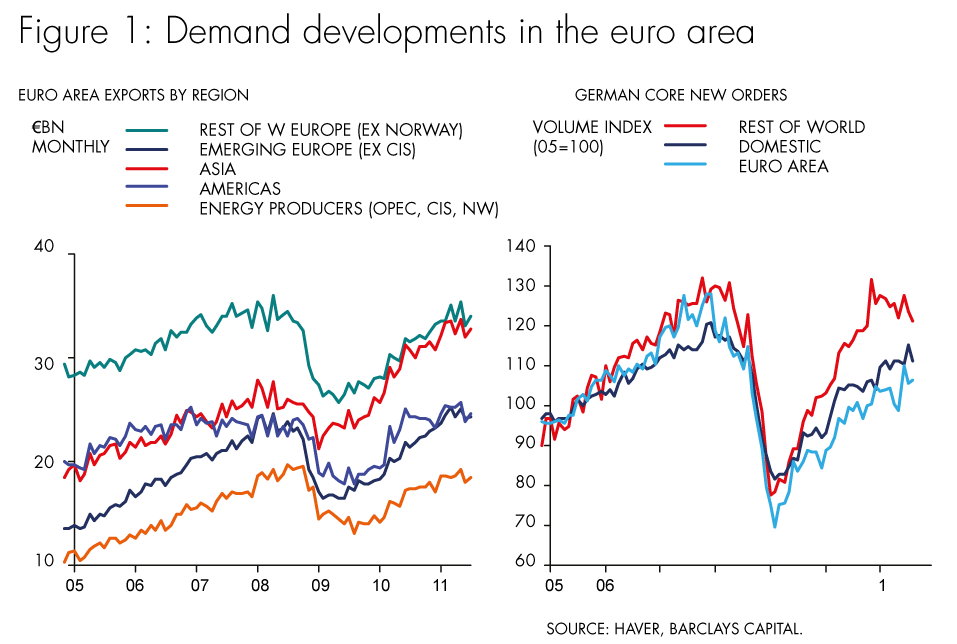By: Julian Callow – Head of European Economics and Sreekala Kochugovindan– Vice President, Global Asset Allocation Strategy at Barclays Capital
The European economy has significantly slowed down over the past two quarters. We look for GDP to contract slightly in 2012. The European Central Bank has cut its policy interest rate by a further 0.25% in December, and we expect further reductions in 2012.
The sluggish rate of economic growth across the euro area masks notable growth differences between member countries. We expect Germany, Finland, Austria and other so-called ‘core’ countries to outperform growth in southern countries such as Italy, Spain, Greece and Portugal. The main reasons for this growth divergence are (a) differences in economic competitiveness (b) the degree to which the government and parts of the private sector are indebted and (c) the differing nature of the financial market shocks. The prevalence of substantial current account deficits still in Greece, Portugal and Spain is an indication that further significant adjustment is needed, given these countries’ substantial levels of externally held debt.
Government financing costs vary substantially between core countries and the southern countries. For example, in Italy, the two-year government funding costs exceeded 7% in November before falling to the current level near 6%. Comparable German rates are hovering around 0.3%. Consequently, businesses in Italy and other southern countries will also face substantially higher funding costs relative to their German, Dutch or Austrian peers. Companies considering future growth of their businesses are likely to be cautious towards investing in southern Europe until governments are able to demonstrate control over fiscal policy and substantial economic liberalisations.
The causes of weak growth in the euro area and the divergence between countries are numerous and intertwined. That said, these are the most important underlying causes at present:
-
Foreign demand growth has slowed considerably in the past few quarters: the sharp rise in global inflation pressures in the first half of 2011 eroded real purchasing power of consumers. Also, rising interest rates impacted global demand adversely, particularly in most large emerging markets. This slowdown in foreign demand was particularly notable in leading euro area export economies such as Germany and is well documented in, for instance, German factory orders (Figure 1).

-
Over the summer and autumn, it became evident that Spain, Italy, Portugal, Greece and France had to announce additional austerity measures to address rising investor concerns about the sustainability of public finances. We estimate that this will reduce real economic growth in 2011/2012 by around one percentage point.
-
The intensification during Q4 2011 of the sovereign debt crisis has brought parts of the euro area to the brink of significant tightening in credit standards.
Nevertheless, despite these adverse developments in the euro area, at a global level other regions have been showing greater stabilisation (such as the US and much of Asia).
Some of these effects are temporary, such as the reconstruction-related surge of activity in Japan. However, the reduction in global inflation should have the effect of encouraging demand growth going forward, while also giving scope for central banks in emerging economies to ease policy (such as is already being seen with a reduction in Chinese bank reserve requirements). The rise in retail sales growth in the US in recent months is one example of this. Given the modest recovery in global demand growth, it seems likely to us that the euro area could avoid a deep recession if the problem of financial sector contagion from Greece and Italy/Spain can be arrested by decisive action.
In conclusion, we continue to be very cautious concerning the European outlook, including central and Eastern Europe (which is materially intertwined with the euro area). Investors and global corporates should keep their focus on those faster growing emerging markets in Asia and Latin America with stable political environments. Amongst the developed countries, investors are likely to focus on Canada, Australia/New Zealand and the Nordic countries.















